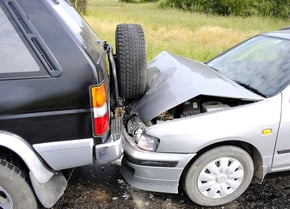MEGAN YOUNG
Account Executive at HNI
 Following too closely (otherwise known as tailgating) continues to be one of the most common causes of serious (and entirely preventable) collisions.
Following too closely (otherwise known as tailgating) continues to be one of the most common causes of serious (and entirely preventable) collisions.
According to the National Highway Traffic Safety Administration following too closely is the second most frequent complaint on the highway today. At low level speeds, it's just annoying -- but get a commercial motor vehicle riding the car ahead while driving over the speed limit and the results can be catastrophic.
This topic is definitely worth a refresher course with your drivers if you haven't discussed it lately!
What's a good guideline for a safe following distance?
Following too closely reduces your visibility of the road ahead and also reduces your reaction time. In drivers' ed, some of us may have been taught the "3 second rule." Maybe that flies when you're driving your Mom's Corolla, but 3 seconds definitely doesn't cut it in a big rig.
|
The formula to calculate Total Safe Following Distance is: Perception Distance + Reaction Distance + Brake Lag Distance + Effective Braking Distance ----------------------------- = Total Safe Following Distance |
Tips to share with your drivers about safe following distance
How can we prevent rear end crashes? All drivers should follow these tips to avoid the dangers of following too closely:
- Be attentive to the road ahead. Looking down or away from the road should be less than 1 second only (ideally as infrequently as possible)
- Avoid any and all distractions. Flipping through your cell phone, texting, and checking email can be so tempting, but the risk just isn't worth it. Apps like "It Can Wait" (or other similar products) could be a good resource to remove the temptation all together for drivers.
- Brake lights are your cue. Treat brake lights ahead as an immediate signal to slow down. Take your foot off the gas and prepare to stop.
- Go with the flow. Or even better, a little less than the flow of traffic in the surrounding vehicles. Maintaining a speed of 2-3 mph less than flow of traffic is recommended -- that way, even if a vehicle jumps into your safe following distance, you will slowly be back to the recommended following distance.
- Budget extra time. Allow plenty of time to reach your destination, and you will be less likely to speed and avoid any need to get into a following too closely situation in the first place.
- Don't treat the speed limit like a goal. Drive at a speed appropriate for all current weather and road conditions. The speed limit is the maximum allowable speed and often it is safer to drive at a slower speed. Make sure to consider traffic, school zones and construction zones. Also consider mechanical conditions such as faulty brakes, air loss or bad tires.
- Never tailgate! Sometimes the driver in front of you is just totally pushing your buttons. But tailgating doesn't "show them," and it puts you and your line of work (your livelihood) at risk.
- Buckle up. I'd be remiss if I didn't throw in a reminder to wear your seat belt. It's your last defense if involved in a crash. Seat belts save lives and professional drivers need to remain in control of their vehicles at all times.
Related Post: A Tactical Guide to Preventing Distracted Driving Accidents
Putting this into practice
It's worth taking the time to remind drivers about safe following distance and some of these basic safety things on an ongoing basis.
Sometimes we hear drivers say things like "well I haven't gotten into an accident, so I'm safe." Just because there hasn't been a major fatality, however, doesn't mean they (or your company) are always being safe. If you get into a rear end collision, you are inches away from killing someone (literally, just inches -- think about the distance from the rear of the car to the drivers seat).
"Near miss" scenarios probably take place more often than we'd like to think about, and management likely doesn't hear about those from drivers. When you truly instill safety as a value in your culture, it doesn't matter if no one's watching -- your drivers will know how to make those tough calls and react on the fly to stay safe in any situation.
Over to you: What have you tried to encourage drivers to keep a safe following distance? Have you used in-cab monitoring technology to help measure this and coach drivers? What do's and don'ts can you share? Let us know in the comments!
Other Related Posts:
Tracy Morgan Crash Shines Spotlight on Culture of Safety in Trucking
The Importance of Corporate Culture: A Tale of Two Companies
Leveraging a Safety Program to Get the Best Rates in a Hard Market
.png?width=69&height=53&name=Acrisure%20Logo%20(White%20Horizontal).png)

